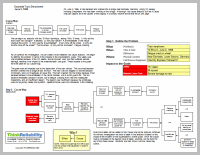June 3, 1998, a train derailed and crashed into a bridge near Eschede, Germany, killing 101 people, including 2 engineers who had been working on the bridge. A thorough root cause analysis built as a Cause Map can capture all of the causes of this tragedy in a simple, intuitive format that fits on one page.We can begin our analysis with the “5 Whys” technique, asking “Why” 5 times. 1) Why did the train crash into a bridge? It derailed. 2) Why did it derail? A tire embedded in the railcar changed the switch. 3) Why was the tire embedded? It had come off the wheel. 4) Why did the tire come off the wheel? The tire broke. 5) Why did the tire break? Fatigue cracking. This forms the beginning of a root cause analysis investigation.
As we continue the investigation, we can create a more detailed root cause analysis. We begin by defining the problem in terms of the impacts to the organization’s goals. The safety goal was impacted because of the 101 deaths, and 88 injuries. Also, the train suffered serious damage, resulting in an impact to the materials/labor cost goal. These impacts to the goals form the basis for our Cause Map.
 The goals were all impacted due to the destruction of the rear railcars. This occurred because the train crashed into a bridge at 200 km/hour. The train was not stopped or slowed because of company policy to investigate an issue first. The train crashed into the bridge because it had derailed because a tire embedded in the railcar collided with a switch guard rail. The tire became embedded because it broke, due to fatigue cracking from wear and inadequate inspections, and an insufficient design. The design was insufficient because the prototypes were not physically tested and dynamic repetitive forces were not considered in the modeling.
The goals were all impacted due to the destruction of the rear railcars. This occurred because the train crashed into a bridge at 200 km/hour. The train was not stopped or slowed because of company policy to investigate an issue first. The train crashed into the bridge because it had derailed because a tire embedded in the railcar collided with a switch guard rail. The tire became embedded because it broke, due to fatigue cracking from wear and inadequate inspections, and an insufficient design. The design was insufficient because the prototypes were not physically tested and dynamic repetitive forces were not considered in the modeling.
Even more detail can be added to this Cause Map as the analysis continues. As with any investigation the level of detail in the analysis is based on the impact of the incident on the organization’s overall goals. Once the Cause Map is completed to the desired level of detail, solutions can be found for any of the cause boxes. Solutions are then shown with the cause they control.
